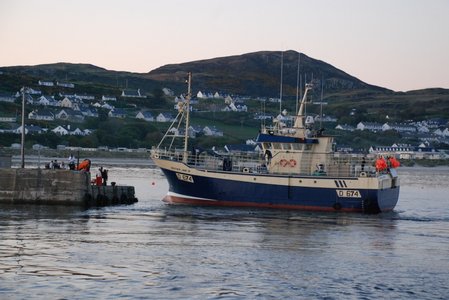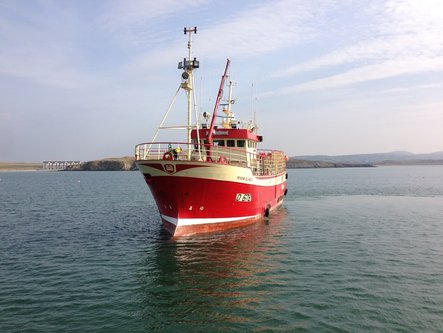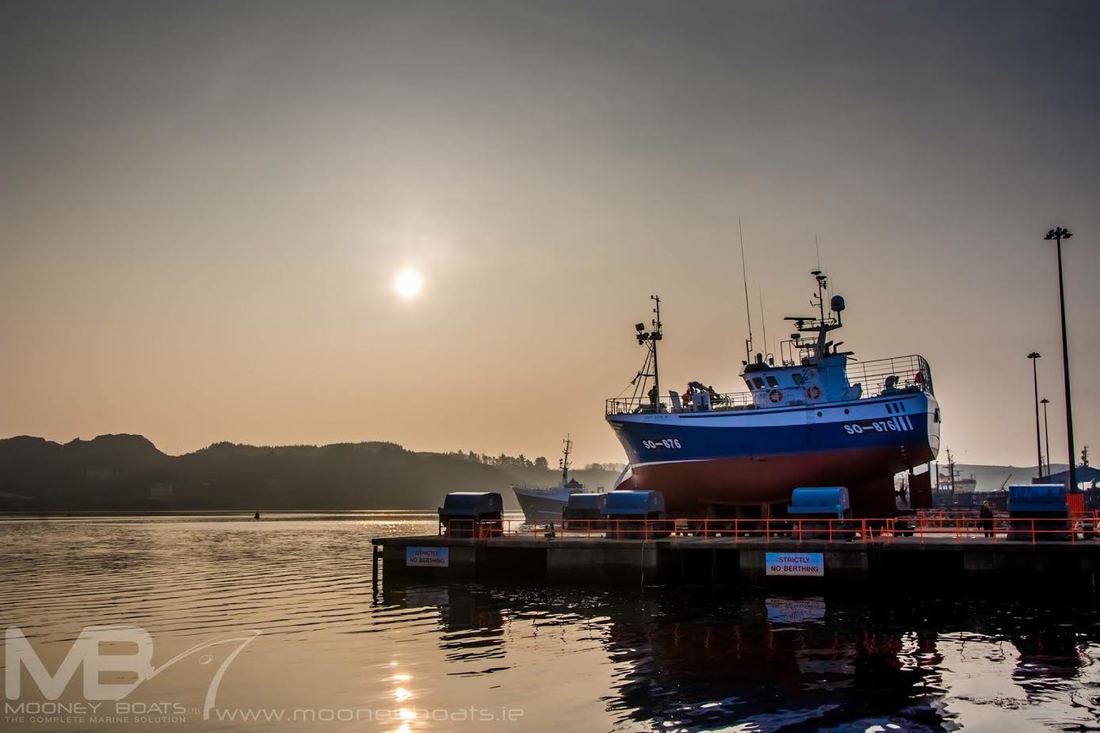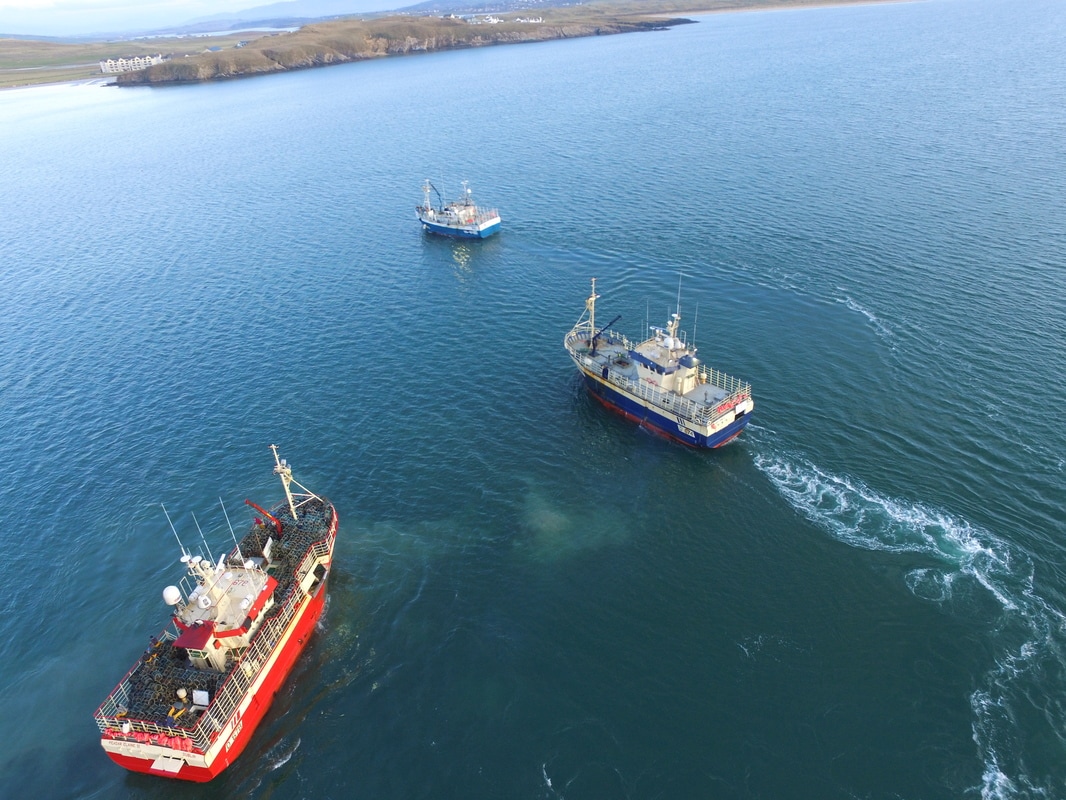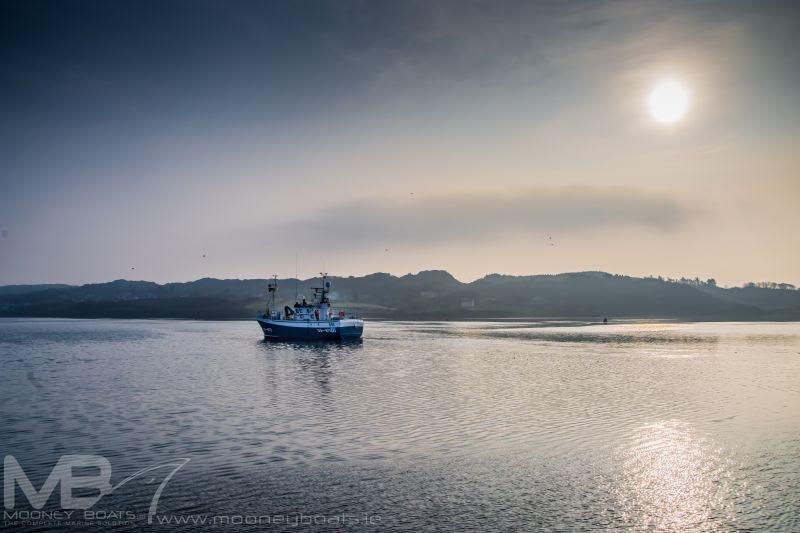|
Heather Jane II & Peadar Elaine II
Both the Heather Jane II (D 674) and the Peader Elaine II (D 678) are identical vessels built of steel by the Spanish shipyard Astilleros Armon in 2000-2001. The vessels are painted and maintained annually to fulfil the Lloyd Class. Both have very high specifications of accommodation and crew facilities with particular features being the automated pot handling system on mid deck which allows for storage and shooting of 150 pots. This automated system incorporates a conveyor system, line transfer haulers, gunwale roller with hydraulic lifts and cranes fitted on these to ensure that on board labour is significantly reduced. Class: Lloyds Register + 100 A1 LMC Fishing Vessel (Class survey annually) Main Engine: Caterpillar 3508 484kW @ 1250rpm Auxillary Engines: 2 x Caterpillar 3304 95kW Power Supply: 220/380V A.C. and 24V D.C. Fishing Facilities: The crab pots are 26 inch D section soft eyed supplied by Gael Force Creel Division and are stored mid-deck in a two-tier hydraulically driven conveyor system. This system can store up to 150 pots and extends from amidships to the transom along the starboard side of the boat. After being untoggled from the back rope, cleared and baited, a short section of conveyor leads the pots through a vertical hatch in the full-width bulkhead that forms the fore-end of the deck casing. The pots then pass onto a second conveyor, the angle of which can be changed to access the two main pot storage racks and conveyors. The conveyors move a pot length at the touch of a button and enable the crew to shoot away the gear either from amidships on the starboard side or at the transom stern. On deck the two tonne Britannica pot hauler is mounted vertically on a console extending down from the underside of the shelterdeck at the starboard shoulder. The pots are hauled straight aboard over a wide gunwale mounted roller onto the stainless steel mounting table. This eliminates the need for crewmen to left every pot aboard at the rail. The clearing table is central to the whole hauling operation and this work is usually carried out by four men on deck. From there the crew can unload the pots and filter the catch. Catch Storage: The catch is transferred below deck and can be worked and stored using the facilities provided. These include two vivier tanks for holding live crab (one 30 cubic metres and one 40 cubic metres), a chilled dry fish room (110 cubic metres) fitted with I.M.F. a Frio refrigeration system to -2 degrees, and a ten tonne bait store refrigerated to -15 degrees. Accommodation: The accommodation facilties on board for crew and scientific guests provide comfortable, clean surroundings for up to twelve people. In addition the galley and dining facilities are also state-of-the-art, the galley being built in stainless steel. The Wheelhouse: The wheelhouse on the vessels provides the skippers with the highest specification of engine control, navigation and communication. Some of the features include Furuno naviagtors and Robertson autopilot and gyrocompass. An office desk is available for completing daily log reports and also has a computer for scientific analysis, email and report writing. |
|
Amy Jane II
The Amy Jane II (So 876) is another vessel built of steel by the Spanish shipyard Astilleros Armon in 2004. This vessel has very high specifications of accommodation and crew facilities with particular features being the automated pot handling system on mid deck which allows for storage and shooting of 150 pots. This automated system incorporates a conveyor system, line transfer haulers, gunwale roller with hydraulic lifts and cranes fitted on these to ensure that on board labour is significantly reduced. Class: Bureau Veritas Main Engine: Caterpillar 3412-C @ 261.1kW Auxillary Engines: 2 x Caterpillar Power Supply: 220/380V A.C. and 24V D.C. Fishing Facilities: The crab pots are 26 inch D section soft eyed supplied by Gael Force Creel Division and are stored mid-deck in a two-tier hydraulically driven conveyor system. This system can store up to 150 pots and extends from amidships to the transom along the starboard side of the boat. After being untoggled from the back rope, cleared and baited, a short section of conveyor leads the pots through a vertical hatch in the full-width bulkhead that forms the fore-end of the deck casing. The pots then pass onto a second conveyor, the angle of which can be changed to access the two main pot storage racks and conveyors. The conveyors move a pot length at the touch of a button and enable the crew to shoot away the gear either from amidships on the starboard side or at the transom stern. On deck the two tonne Britannica pot hauler is mounted vertically on a console extending down from the underside of the shelterdeck at the starboard shoulder. The pots are hauled straight aboard over a wide gunwale mounted roller onto the stainless steel mounting table. This eliminates the need for crewmen to left every pot aboard at the rail. The clearing table is central to the whole hauling operation and this work is usually carried out by four men on deck. From there the crew can unload the pots and filter the catch. Catch Storage: The catch is transferred below deck and can be worked and stored using the facilities provided. These include two vivier tanks for holding live crab (one 30 cubic metres and one 40 cubic metres), a chilled dry fish room (110 cubic metres) fitted with I.M.F. a Frio refrigeration system to -2 degrees, and a ten tonne bait store refrigerated to -15 degrees. Accommodation: The accommodation facilties on board for crew and scientific guests provide comfortable, clean surroundings for up to seven people. In addition the galley and dining facilities are also state-of-the-art, the galley being built in stainless steel. The Wheelhouse: The wheelhouse on the vessels provides the skippers with the highest specification of engine control, navigation and communication. Some of the features include Furuno naviagtors and Robertson autopilot and gyrocompass. An office desk is available for completing daily log reports and also has a computer for scientific analysis, email and report writing. |

